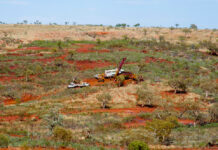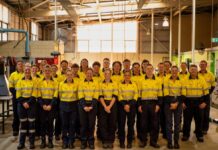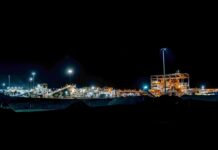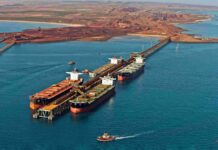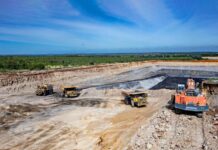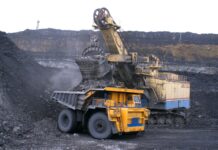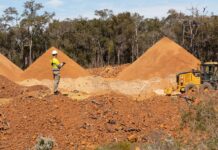Alongside excess noise and vibration, perhaps the chief long-term threat to worker safety at a mine site is suspended particulate matter, or dust, generated by the daily operations of mining.
At its most extreme, long-term exposure to coal dust can produce coal worker’s pneumoconiosis, or ‘black lung’, a respiratory condition in which a worker’s lung degrade and turn black from coal dust exposure. Though black lung is perhaps the most extreme example of the hazardous effects of dust exposure, respiratory ailments such as asthma and bronchitis brought on by long-term exposure can also have debilitating effects of a worker’s health and productivity.
Only preventative dust monitoring and suppression methods can hope to block the emergence of these types of corrosive health conditions. Importantly, every stage of mineral extraction and processing has the potential to generate dangerous forms and levels of dust. Everything from blast crew and dragline operations to crushing and topsoil stripping generate suspended particulate matter, and pose a health hazard to the workforce.
Dust particles fall into two categories, according to their size: inhalable dust is particulate matter measuring approximately 0.1mm in diameter, and respirable dust is particulate matter measuring approximately 0.005mm in diameter. The size of a dust particle determines how far it can travel into the lungs.
Though regulations shift depending on a range of factors, the general standard is that exposure to inhalable dust must fall below 10mg/m3, over an eight-hour time-weighted average, and exposure to respirable dust must fall below 5mg/m3 for the same time-weighted average. For coal mining, the regulations are more stringent.
An immediate problem that confronts companies working under these regulations is one of measurement and precision. How can operators precisely and effectively measure and monitor the amount of particulate matter in the air, at all times and in all areas of a mine site?
To solve this problem, TecPro offers operators the DustRoid monitoring system. It’s an elegant and effective example of smart technology that promises to refine dust monitoring to a new height of precision. In conjunction with TecPro’s suite of dust suppression equipment, companies can build a comprehensive and detailed dust monitoring and suppression blanket over the mine site.
To begin with, let’s examine the DustRoid system.
The DustRoid System
DustRoid is a pole-mounted real-time and online dust monitoring station that fulfills two basic functions.
Firstly, it offers companies a detailed information stream measuring the concentration of dust particles in ambient air. It is capable of monitoring various particulate sizes ranging from 1 micron (u) to 100 u such as Ultrafine Suspended Particulate Matter (UFPM), Suspended Particulate Matter (SPM), Respiratory Particulate Matter (RSPM) and Total Suspended Particulates (TSP). It works on an active sampling method to count particulate matters using a highly accurate laser beam.
More specifically, once the device is powered on, the device intakes air samples at a predefined frequency through the sampling system. The sensor uses a light scattering method and emits a laser beam to diffract through the air sample. The intensity of the beam scattered from the particles at an angle of 45-90o informs about the particle size distribution and particle concentration.
This quantitative function is the most refined on the market. A sweep of detailed parameters are measured by this system. Namely, PM1, or UFPMs with a size less than 1u, PM2.5, or SPMs with a size less than 2.5u, and PM10, or SPMs with a size less than 10u, are measured to a range of 0-1000 ug/m3 to a resolution of 0.3 ug/m3 with a minimum detection of 1 ug/m3.
The sample rate of PM1, PM2.5 and PM 10 is 1 l/min. For PM100, or TSP, DustRoid measures to a range of 0-30,000 ug/m3 at a resolution of 1 ug/m3 with a minimum detection of 1ug/m3. The sample rate is 325ml per sample.
Secondly, the DustRoid system works as an alarm and trigger system. Perhaps the most impressive feature of DustRoid is the way in which it integrates with and amplifies a pre-existing dust suppression system. Particular thresholds, set by mine regulators across Australia, are keyed into the monitoring station, and when these thresholds are met or breached, DustRoid will automatically trigger an alarm to the site’s dust suppression crew, or activate dust suppressants such as mist cannons, sprinklers, mechanical barriers, dust collectors or dust filters built into the site, to begin the work of dust suppression.
Dust is suppressed effectively when the size of the mist droplets generated by a dust suppressant system matches the size of the dust particles emitted during the mining process. The dust particle and mist droplet combine, and then fall to the ground.
As a piece of smart technology, the data gathered by DustRoid is collected in real-time and communicated at a configurable data interval of 2-30 minutes. The data can be transmitted by a range of wireless or wired connectivity options such as GSM, GPRS, WiFi, LoRa, NbloT and Ethernet. This means the DustRoid system can integrate itself immediately into whatever IT system a site has established, just the kind of versatility demanded by diverse and complex operations.
The scope and detail of information gathered by DustRoid coupled with its real-time data transmission means operators are never in the dark about dust levels across their site. Dust crews can react and respond to problems with precision and intelligence, knowing exactly where and when dust levels are breaching acceptable levels.
One immediate benefit of this refined measurement system is that companies know where to direct resources to best achieve its dust suppression goals. As each part of the site is covered by a particular monitoring station, the total site can be broken down and analysed in parts. If a particular part is breaching thresholds, the dust management team can focus resources and attention to that particular problem, as opposed to clumsily trying to reduce dust across the board. This means sharpened allocation of capital, and a leaner, more productive operation.
Once the dust suppressant mechanisms are triggered by the alarms set off by DustRoid, they can begin to immediately go to work to keep dust levels within regulated limits, ensuring that companies can swiftly and properly adhere to environmental regulations and protect the safety and productivity of their workforce at all times throughout operations.
Installation
An attractive feature of DustRoid is the non-intrusive simplicity of its design.
It is a light-weight and compact system, weighing just 6.5kg and measuring 147mm in height, 314mm in width, and 261mm in depth. It is mounted to a pole at an elevation of 4-5m. This is done to ensure a free-flow of air for the sensor. It can also be mounted to a wall-face.
And because it is compact and easily to set-up, it can be positioned effectively any place where dust generation is a concern. The diagram below demonstrates where the system can be positioned. Whether it is at the entry points of a site or near diggers and haul trucks, DustRoid is designed to cover every part and process of the site, and record dust levels at each of the mineral extraction and processing stages.
It is powered by a lithium-ion battery with a backup battery time of 48 hours, giving companies the security of stable and undisrupted monitoring.
Furthermore, it is designed to function in harsh conditions, a necessity for any piece of equipment shipped out to Australian mine sites. DustRoid has an operating temperature of -20oC to 60oC, with an optimum operating temperature between 25 oC and 35 oC. It also has operating humidity levels of 0-90%, and IP65 weather protection. So whether it’s a coal mine in Central Queensland, or a gold mine in WA, DustRoid can withstand the harshest operating environments Australia has to offer.
Dust Suppressants
In addition to DustRoid, TecPro cooperates with a number of suppliers to offer operators an extensive and comprehensive array of dust suppression systems. From large-scale equipment such as cannons all the way down to smaller fixed systems on transfer points, TecPro offers everything a company needs to build and maintain a comprehensive dust suppression blanket over its mine site.
Specifically, TecPro offers wide range of spray nozzles, hose guns and foaming units, hose reels, CIP tank cleaning products, misting systems, large-scale dust controllers, filter nozzles and valves, filters and other accessories.
These products, in conjunction with DustRoid, offer operators the best way to erect an effective dust monitoring and suppression regime, across all areas of a site and in all working conditions.
Consulting
More than this, TecPro is a widely respected consultant in the field of dust suppression, with years of deep knowledge and experience in the field.
Each mine site is different, and there is no such thing as a ‘one size fits all’ system that can accommodate the diverse needs of operators. More than that, each part of the mine will demand a different technique to adequately control and suppress dust emanating from that particular source.
Which system is best suited for a particular situation depends of a variety of factors, such as the type and concentration of dust being generated and the availability of water supply. TecPro offers operators specialist advice on how to formulate the best dust suppression systems for haul roads, ROM bins and dump hoppers, conveyors, crushers, stockpiles, rail cars and longwall mining.
Case Study
Its work with Centennial Coal’s Mandalong mine is a case in point. The Mandalong mine is an underground mine that produces a considerable amount of dust. Specifically, a dangerous amount of dust was being generated at the point where the coal drops from the crusher into the underground bin.
Centennial Coal tried a number of approaches to suppress the dust, but none were as successful as hoped, and so the company turned to TecPro to design a more effective dust suppression system.
TecPro, in conjunction with Wollongong University, designed a custom crusher dust suppression system and ROM bin dust suppression system to meet the specific needs of a complex situation. The design was a success, and following the installation of these systems, respirable dust emissions were reduced by some 68%. What’s more, with a full load of spray nozzles in operation, the TecPro system can reduce dust by more than 90%, a fantastic solution to a vexing problem.
The Future
With DustRoid, TecPro is elevating dust monitoring and suppression to a new height of precision and intelligence. Combined with its extensive experience in consulting and specialist design, TecPro can offer operators across Australia the kind of premium technology and service demanded by a world-class industry.
Tecpro Australia
Ph: +61 (02) 9634 3370
Email: sales@tecpro.com.au
Online: www.tecpro.com.au

